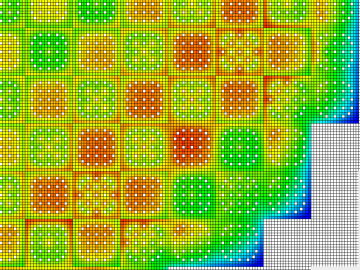
Filter News
Area of Research
- Advanced Manufacturing (2)
- Biology and Environment (11)
- Computational Biology (1)
- Computational Engineering (1)
- Computer Science (2)
- Electricity and Smart Grid (1)
- Energy Science (47)
- Fusion and Fission (5)
- Fusion Energy (4)
- Isotopes (3)
- Materials (9)
- Materials for Computing (6)
- National Security (9)
- Neutron Science (11)
- Nuclear Science and Technology (9)
- Nuclear Systems Modeling, Simulation and Validation (1)
- Sensors and Controls (1)
- Supercomputing (27)
- Transportation Systems (1)
News Topics
- (-) Advanced Reactors (16)
- (-) Artificial Intelligence (15)
- (-) Grid (17)
- (-) Mercury (4)
- (-) National Security (9)
- (-) Space Exploration (6)
- (-) Summit (26)
- (-) Transportation (36)
- 3-D Printing/Advanced Manufacturing (54)
- Big Data (16)
- Bioenergy (26)
- Biology (28)
- Biomedical (32)
- Biotechnology (7)
- Buildings (14)
- Chemical Sciences (12)
- Clean Water (10)
- Composites (7)
- Computer Science (69)
- Coronavirus (35)
- Critical Materials (6)
- Cybersecurity (9)
- Energy Storage (42)
- Environment (68)
- Exascale Computing (5)
- Frontier (5)
- Fusion (21)
- High-Performance Computing (22)
- Isotopes (20)
- ITER (4)
- Machine Learning (9)
- Materials (34)
- Materials Science (59)
- Mathematics (3)
- Microscopy (18)
- Molten Salt (2)
- Nanotechnology (27)
- Neutron Science (55)
- Nuclear Energy (37)
- Physics (16)
- Polymers (12)
- Quantum Computing (5)
- Quantum Science (26)
- Security (6)
- Statistics (1)
Media Contacts

Scientists at Oak Ridge National Laboratory used new techniques to create a composite that increases the electrical current capacity of copper wires, providing a new material that can be scaled for use in ultra-efficient, power-dense electric vehicle traction motors.

Radioactive isotopes power some of NASA’s best-known spacecraft. But predicting how radiation emitted from these isotopes might affect nearby materials is tricky

A developing method to gauge the occurrence of a nuclear reactor anomaly has the potential to save millions of dollars.

As CASL ends and transitions to VERA Users Group, ORNL looks at the history of the program and its impact on the nuclear industry.

Oak Ridge National Laboratory researchers have developed artificial intelligence software for powder bed 3D printers that assesses the quality of parts in real time, without the need for expensive characterization equipment.

Oak Ridge National Laboratory researchers have developed a machine learning model that could help predict the impact pandemics such as COVID-19 have on fuel demand in the United States.

Combining expertise in physics, applied math and computing, Oak Ridge National Laboratory scientists are expanding the possibilities for simulating electromagnetic fields that underpin phenomena in materials design and telecommunications.

After its long journey to Mars beginning this summer, NASA’s Perseverance rover will be powered across the planet’s surface in part by plutonium produced at the Department of Energy’s Oak Ridge National Laboratory.

ORNL researchers have developed an intelligent power electronic inverter platform that can connect locally sited energy resources such as solar panels, energy storage and electric vehicles and smoothly interact with the utility power grid.

A team led by Dan Jacobson of Oak Ridge National Laboratory used the Summit supercomputer at ORNL to analyze genes from cells in the lung fluid of nine COVID-19 patients compared with 40 control patients.


